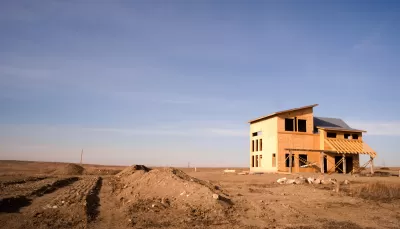New data reveals how far the U.S. housing market has stayed from anything resembling normal.

"Much of the housing market has gone missing."
That's the provocative lede of a story by Emily Badger and Quoctrung Bui that quantifies the state of the national for-sale housing market. Homes that usually would have been up for sale are staying off the market—about half as many homes are available for sale right now as last winter, according to the article.
The story is the same in markets historically defined by much different dynamics—so inventory is down in Atlanta, Austin, Chicago, and Cleveland, for example. The decline in inventory is "record shattering," according to the article, and it follows years of erosion in the national housing inventory. "This picture is a product of the pandemic, but also of the years leading up to it," according to Badger and Bui.
Analysis cited in the article chalk up the unprecedented status of the market to the tricky dynamics on the supply side during the pandemic. "Who wants to sell a house in the middle of a pandemic?" says Benjamin Keys, an economist at the Wharton Business School at the University of Pennsylvania. According to Ralph McLaughlin, the chief economist at Haus, a housing finance start-up, who is also quoted int eh article, every market that's withheld from the market creates an incentive for others not to sell their homes.
Then there's the economic woes, which is contributing to an inability of many homeowners to make their mortgage payments.
"At the peak, more than four million homeowners with government-backed loans were in mortgage forbearance during the pandemic (about 2.6 million still are). While that government policy, recently extended through June, has been a lifeline for many families who’ve lost income, it has also meant that some homes that most likely would have come on the market over the past year, either through foreclosure or a forced sale, did not."
The article is built on data from Altos Research, a real-estate market tracking firm, and includes infographics and a lot more historical and economic context for the current state of the housing market.
FULL STORY: Where Have All the Houses Gone?

Maui's Vacation Rental Debate Turns Ugly
Verbal attacks, misinformation campaigns and fistfights plague a high-stakes debate to convert thousands of vacation rentals into long-term housing.

Planetizen Federal Action Tracker
A weekly monitor of how Trump’s orders and actions are impacting planners and planning in America.

San Francisco Suspends Traffic Calming Amidst Record Deaths
Citing “a challenging fiscal landscape,” the city will cease the program on the heels of 42 traffic deaths, including 24 pedestrians.

Defunct Pittsburgh Power Plant to Become Residential Tower
A decommissioned steam heat plant will be redeveloped into almost 100 affordable housing units.

Trump Prompts Restructuring of Transportation Research Board in “Unprecedented Overreach”
The TRB has eliminated more than half of its committees including those focused on climate, equity, and cities.

Amtrak Rolls Out New Orleans to Alabama “Mardi Gras” Train
The new service will operate morning and evening departures between Mobile and New Orleans.
Urban Design for Planners 1: Software Tools
This six-course series explores essential urban design concepts using open source software and equips planners with the tools they need to participate fully in the urban design process.
Planning for Universal Design
Learn the tools for implementing Universal Design in planning regulations.
Heyer Gruel & Associates PA
JM Goldson LLC
Custer County Colorado
City of Camden Redevelopment Agency
City of Astoria
Transportation Research & Education Center (TREC) at Portland State University
Jefferson Parish Government
Camden Redevelopment Agency
City of Claremont





























